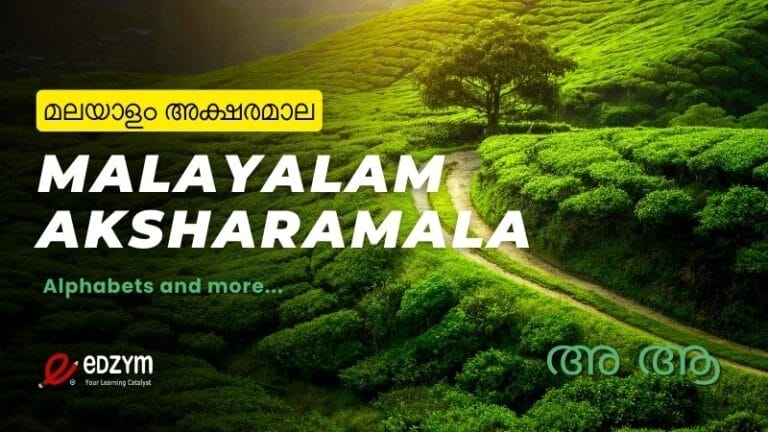Malayalam Language | History, Grammar, and Essential Insights | Edzym
Malayalam is a rich and vibrant language spoken primarily in the Indian state of Kerala, with a substantial presence in the Lakshadweep islands and among the Malayali diaspora worldwide. On May 23, 2013, Malayalam was officially recognized as a Classical Language by the Government of India. As one of the 22 officially recognized languages of India, Malayalam plays a crucial role in the cultural and social fabric of Kerala.
This Dravidian language, part of the South Dravidian group, is known for its unique script and complex phonetic structure. It is not only a means of communication but also a vessel of Kerala’s diverse heritage, history, and tradition.
In this article, we’ll explore Malayalam’s origins, its linguistic features, and its cultural significance, providing a comprehensive understanding of why this language holds such importance in both historical and contemporary contexts. Whether you’re a language enthusiast, a student, or simply curious about Kerala’s rich cultural landscape, this guide will offer valuable insights into the Malayalam language.
Malayalam Language History and Origins
Early History of Malayalam
Malayalam is a language with deep historical roots, tracing its origins back to the ancient Dravidian language family. The earliest forms of Malayalam can be found in the inscriptions and literary works of the region dating back to the 9th century AD. The language evolved from Tamil, an ancient Dravidian language, and began to develop its own distinct characteristics over time.
Evolution Over Time
The evolution of Malayalam can be broadly divided into three stages:
- Old Malayalam (circa 9th to 13th century AD): This period saw the emergence of Malayalam as a separate language from Tamil. Early Malayalam literature, including religious texts and poems, began to take shape during this time. The language started to acquire its unique grammatical and phonological traits.
- Middle Malayalam (circa 13th to 17th century AD): This phase witnessed further diversification and standardization of the language. Middle Malayalam saw the development of a rich body of literature, including epics and devotional poetry. It also saw significant influences from Sanskrit and Arabic due to cultural and trade interactions.
- Modern Malayalam (18th century to present): The modern era brought about significant changes in the language due to British colonial influence and the spread of education. The language continued to evolve, incorporating new vocabulary and expressions while maintaining its traditional roots. Contemporary Malayalam is characterized by its rich literature, cinema, and media presence.
Influence from Other Languages and Cultures
Malayalam has been influenced by various languages and cultures throughout its history. Key influences include:
- Sanskrit: The language has absorbed a considerable amount of vocabulary and stylistic elements from Sanskrit, especially in its literary and formal registers.
- Arabic and Persian: Due to historical trade relations and the presence of the Muslim community, Malayalam has incorporated many words from Arabic and Persian.
- English: British colonial rule introduced English terms into Malayalam, especially in administrative, educational, and technological contexts.
These influences have contributed to the linguistic richness and diversity of Malayalam, making it a dynamic and evolving language.

Geographical Distribution
Regions Where Malayalam is Spoken
Malayalam is primarily spoken in the Indian state of Kerala, which is located on the southwestern coast of the country. It is also spoken in the Lakshadweep islands, which lie to the west of Kerala. Additionally, Malayalam-speaking communities can be found in various parts of India and abroad due to migration.
Major Cities and States
- Kerala: The heartland of the Malayalam-speaking population, with major cities including Thiruvananthapuram (the state capital), Kochi, and Kozhikode.
- Lakshadweep: A group of islands where Malayalam is widely spoken.
- Diaspora: Significant Malayali communities exist in the Gulf countries, the United States, the United Kingdom, Canada, and Australia, among others.
This geographical spread highlights the importance of Malayalam not only within its native region but also in the global context.
Linguistic Characteristics of Malayalam
Alphabet and Script
Malayalam aksharamala (alphabet) uses a unique script derived from the Brahmi script. It is a syllabic alphabet, meaning each character represents a syllable rather than an individual sound. The script is characterized by its rounded shapes and is written from left to right.
- Number of Letters: The script includes 15 vowels and 36 consonants.
- Special Characters: There are special characters for various sounds and diacritics used to modify consonants and vowels.
Malayalam Phonetics and Phonology
Malayalam’s phonetic system includes a wide range of sounds, including:
- Vowels: The language has a variety of vowel sounds that can be short or long.
- Consonants: Malayalam features a rich array of consonants, including retroflex sounds, which are pronounced with the tongue curled back against the roof of the mouth.
Malayalam Grammar and Syntax
Malayalam grammar is known for its complexity, but some key features include:
- Sentence Structure: The typical word order in Malayalam is Subject-Object-Verb (SOV).
- Nouns: Nouns are inflected for case, number, and gender.
- Verbs: Verbs are conjugated based on tense, aspect, and mood.
Tense and Aspect
Malayalam verbs convey various tenses (past, present, future) and aspects (completed, ongoing, habitual), which help to express the timing and nature of actions.
This section provides a snapshot of Malayalam’s linguistic features, offering a foundation for understanding how the language operates in both written and spoken forms.
Vocabulary and Usage
Common Phrases and Expressions
Understanding common phrases and expressions is key to grasping the practical use of Malayalam in everyday conversations. Here are a few essential phrases:
- Hello: “നമസ്കാരം” (Namaskāraṁ)
- Thank you: “നന്ദി” (Nandi)
- How are you?: “സുഖമാണോ?” (Sukhamaano?)
- Yes: “അതെ” (Athe)
- No: “അല്ല” (Alla)
- Please: “ദയവായി” (Dayavāyi)
Everyday Malayalam Vocabulary
Some everyday vocabulary that’s useful for both travelers and learners includes:
- Food: “അഹാരം” (Ahāraṁ)
- Water: “നീര്” (Nīr)
- House: “വീട്” (Vīṭu)
- Friend: “സഹോദരന്/സഹോദരി” (Sahōdaran/Sahōdari)
- Market: “മാർക്കറ്റ്” (Mārkkaṭṭ)
- Book: “പുസ്തകം” (Pustakaṁ)
Formal vs. Informal Language
Malayalam, like many languages, has variations between formal and informal registers. Formal Malayalam is often used in official documents, literature, and public speeches, while informal Malayalam is used in daily conversations and casual settings.
- Formal:
- “നമസ്ക്കാരം” (Namaskkāraṁ) – used in formal greetings
- “ഞാൻ സന്തുഷ്ടനാണ്” (Ñāṉ santhuṣṭan āṇu) – “I am pleased” (more formal expression)
- Informal:
- “ഹലോ” (Halo) – a casual greeting
- “എന്തുണ്ട് വിശേഷം?” (Enthundu viśēṣaṁ?) – “What’s up?” (informal)
To enhance your vocabulary, check out our comprehensive guide on common Malayalam words. This resource will help you familiarize yourself with essential phrases and expressions used in everyday conversations.
Dialects and Variants
Major Dialects within Kerala
Malayalam is spoken in various dialects across Kerala, reflecting the state’s rich cultural diversity. Some notable dialects include:
- Northern Dialects: Spoken in regions like Kozhikode and Kannur, these dialects often feature a distinct pronunciation and vocabulary compared to other areas.
- Central Dialects: Found in regions like Thrissur and Ernakulam, central dialects are considered to be somewhat closer to the standard form of Malayalam.
- Southern Dialects: Spoken in districts like Thiruvananthapuram and Kollam, these dialects may have unique phonetic characteristics and expressions.
Differences in Vocabulary and Pronunciation
Dialectal differences can be significant, affecting pronunciation, vocabulary, and even grammar. For instance:
- Vocabulary: Words for everyday items might vary. For example, the word for “rice” is “അരി” (Ari) in some northern dialects but “അന്നം” (Annam) in others.
- Pronunciation: The way certain consonants and vowels are pronounced can differ. For example, the retroflex sounds may be more pronounced in the northern dialects.
Cultural Significance
Role of Malayalam in Literature and Media
Malayalam boasts a rich literary tradition that spans classical poetry, modern novels, and theatrical works. It has a vibrant media presence with numerous newspapers, magazines, and television channels broadcasting in the language. Notable literary figures include:
- Vallathol Narayana Menon: A prominent poet known for his contributions to Malayalam literature.
- O. Chandumama: An acclaimed writer known for his novels and short stories.
For a deeper dive into the influential figures of Malayalam literature, explore our article on famous Malayalam poets and discover the profound works of writers like Vallathol Narayana Menon and Sugathakumari, who have shaped the language’s literary landscape.
Influence on Kerala’s Culture and Identity
Malayalam is integral to Kerala’s cultural identity. It is the medium through which traditional art forms, folklore, and religious practices are expressed. Festivals, such as Onam and Vishu, are celebrated with songs and dramas performed in Malayalam.
Famous Malayalam Authors and Poets
- C.V. Raman Pillai: Renowned for his historical novels.
- Kamala Das: Famous for her poetry and autobiographical works that reflect personal and cultural themes.
Learning Malayalam
Understanding the Malayalam language’s history, grammar, and essential insights provides a deeper appreciation for its literary richness, including the profound wisdom encapsulated in Malayalam pazhamchollukal.
Resources for Beginners
If you’re interested in learning Malayalam, there are several resources available:
- Books: Language textbooks and grammar guides can provide structured learning.
- Online Courses: Platforms like Edzym, Duolingo and Coursera offer Malayalam courses.
- Personalized Lessons: Edzym’s learn Malayalam course can connect you with native tutors for personalized learning.
Tips for Language Learners
- Immerse Yourself: Listen to Malayalam music, watch Malayalam films, and practice speaking with native speakers.
- Practice Regularly: Consistent practice helps reinforce learning and build fluency.
- Learn the Script: Familiarizing yourself with the Malayalam script can greatly enhance your reading and writing skills.
Online Tools and Apps
Several digital tools can aid your learning:
- Google Translate: Useful for quick translations and understanding basic phrases.
- Chatgpt: Although not fully accurate, it can be handy for getting started and facilitating basic interactions.
Challenges and Modern Trends
Challenges Faced by the Language
Despite its rich heritage, Malayalam faces challenges such as:
- Language Shift: Younger generations may prefer English or other languages, potentially impacting the use of Malayalam.
- Digital Divide: Limited digital resources in Malayalam compared to more widely spoken languages.
Efforts to Preserve and Promote Malayalam
Various initiatives aim to promote and preserve Malayalam, including:
- Cultural Organizations: Groups and institutions work to support Malayalam literature and arts.
- Government Initiatives: Efforts to integrate Malayalam into educational curricula and official communication.
Influence of Technology and Globalization
Technology and globalization have brought both opportunities and challenges. While digital media help spread the language globally, there is also a risk of linguistic homogenization.
FAQ: About the Malayalam Language
Conclusion
Malayalam is a language with a deep historical legacy and a vibrant cultural presence. Its unique script, diverse dialects, and rich literary tradition make it a fascinating subject of study. Whether you are exploring Malayalam for personal enrichment or academic purposes, understanding its history, characteristics, and cultural significance will enhance your appreciation of this dynamic language.
If you’re wondering how to learn Malayalam, we offer personalized one-on-one Malayalam classes tailored to learners of all levels. Our native Malayalam tutors from Kerala provide expert instruction to help you achieve your language goals. You can try a FREE demo class by filling out the form below.









